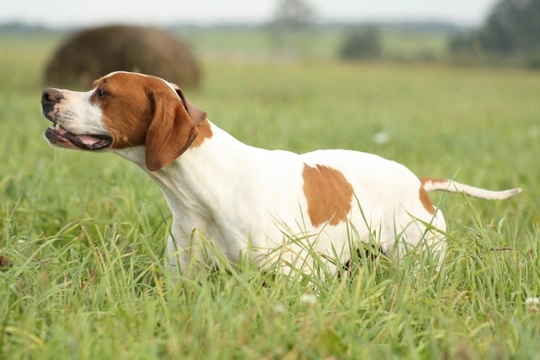
Five interesting facts about the pointer dog breed
The pointer (also known as the English pointer) is a medium sized dog breed from the gundog grouping, and so has a long working history. They are fairly unique in terms of their working talent and what they are good for, which is essentially pointing or birding-spotting a bird in the rough and using its body and voice to literally point at it, so that the handler can locate the prey and take action.
Their size, coats and good temperaments also make them very versatile and popular as pets for people from all walks of life too, and today, the pointer is more commonly kept as a pet than as a working dog. However, while they tend to be great company and very friendly and entertaining, they are not necessarily a good choice of pet for everyone, and they need lots of exercise and entertainment to keep them happy and amenable to family life.
If you are considering buying or adopting a pointer or are simply interested in the breed and want to find out a little more about them, this article will share five interesting facts about the breed that you might not already know about. Read on to learn more.
They have a diverse and interesting history
There are several different pointer-type breeds as well as the English pointer, such as the Hungarian Vizsla and the Spanish pointer. All dogs of this type tend to have a similar appearance, and are medium sized and short coated with a proportionate build and lean musculature.
The first English pointers originated from their Spanish cousins, as British army officers returning from the War of Spanish Succession in 1713 brought Spanish pointer dogs home with them when they returned to England. Later imports of Italian pointing dogs were crossed with the Spanish pointer within the UK, to create the breed that we know today as the English pointer, or simply pointer.
They were used for bird hunting even before gun sport took off
The pointer’s original working role was of course for pointing, a trait that we will look into in more detail below. However, this trait became recognised before gun sport even took off, and dogs of the pointer type were widely used for bird hunting in the rough, chasing and catching their prey and either breaking its neck to make the kill, or taking it back to their handlers.
As gun sport and shooting parties then became more popular within the UK, the pointer’s role became refined to that of pointing and alerting handlers, rather than locating prey and following through with a catch and kill.
The pointing trait
The pointer name of course comes from the dog’s most distinctive signature trait-pointing. When a pointer spots prey (or within a domestic setting, something else of interest-such as the approach of someone that they know)-they take on their signature pointing pose, in which their whole body becomes rigid with energy, and the shape and direction of their body literally “points” to the thing that they are looking at.
This alerts their handler to the source of their interest, and allows the, to get closer while the dog pins the prey and take action.
This generally means that while pointers will spot prey and pinpoint it, they will rarely actually attack or attempt to make contact with it, unlike other working hunting dog breeds that usually go in for the kill.
They are excellent companions for children
The pointer personality is one of their most appealing features, as well as their good looks! They are bold, outgoing and friendly and notably not shy with strangers, but they also have open, happy temperaments that makes them bold and un-phased by change.
This means that they tend to get on well with strangers and will rarely come over as shy or speculative, and they make friends easily. They are notably excellent companions for children, having a natural ability to modulate their behaviour to avoid knowing over or hurting a young child, and loving to play and socialise with anyone who wants to play with them!
They are quite protective of their homes and families and so can make for good watchdogs, but they do not really have a strong guarding instinct, and so if someone tried to enter your property, they would likely bark a lot but not make any physical moves to stop them!
They needs lots of exercise and entertainment
Like all dog breeds that have a working history, the pointer is a very energetic breed that needs lots of exercise and stimulation in order to be happy within a domestic home. This means long periods of exercise and play every day, as well as mental stimulation, such as playing interactive games or canine sports that allows for an outlet for the dog’s mental, as well as physical energy.



